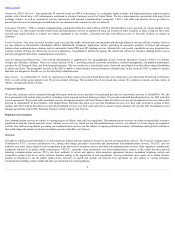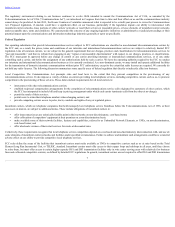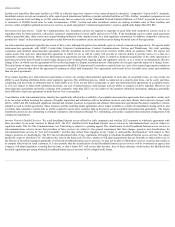Earthlink 2015 Annual Report Download - page 19
Download and view the complete annual report
Please find page 19 of the 2015 Earthlink annual report below. You can navigate through the pages in the report by either clicking on the pages listed below, or by using the keyword search tool below to find specific information within the annual report.
Table of Contents
• diversion of management's attention and resources that would otherwise be available for the current operation of our business;
• failure to fully achieve expected synergies and costs savings or anticipated benefits may take longer;
• higher integration costs than anticipated;
• the impact on employee morale and the retention of employees, many of whom may have specialized knowledge about the business;
• lost revenues or opportunities as a result of our current or potential customers or strategic partners deciding to delay or forego business;
• difficulties combining product offerings and entering into new markets in which we are not experienced;
•difficulties integrating the sales organizations of acquired companies;
• the integration of departments, operating support systems, such as provisioning and billing systems, and technologies, such as network equipment;
and
• the need to implement and maintain uniform controls, procedures and policies throughout all of our acquired companies or the need to remediate
significant control deficiencies that may exist at acquired companies
Risks Related to Our Business Services
We face significant competition in our business markets, which could adversely affect our results of operations.
The market for our business customers is highly competitive, and we expect this competition to continue to intensify. Our business markets are rapidly changing
due to industry consolidation, an evolving regulatory environment and the emergence of new technologies. Our primary competitors are incumbent local exchange
carriers (“ILECs”), such as AT&T, CenturyLink, Inc. and Verizon Communications Inc.; competitive local exchange carriers (“CLECs”), such as Global Capacity,
Level 3 Communications Inc., Windstream Holdings, Inc. and XO Communications; cable service providers, such as Charter Communications, Inc., Comcast
Corporation, Cox Communications, Inc. and Time Warner Cable; wireless service providers; and asset-light network companies. We also compete with various
other service providers for our managed network, security and cloud services, including managed hosting and cloud providers, managed security companies,
technology companies, hardware manufactures and system integrators. For more information regarding competition, refer to Item 1 of this Annual Report on Form
10-K.
We believe the primary competitive factors in our business markets include price, availability, reliability of service, network security, variety of service offerings,
quality of service and reputation of the service provider. While we believe our business services compete favorably based on some of these factors, we are at a
competitive disadvantage with respect to certain of our competitors. Many of our current and potential competitors have greater market presence, technical and
marketing capabilities and financial, personnel and other resources substantially greater than ours; own larger and more diverse networks; are subject to less
regulation; or have substantially stronger brand names. In addition, industry consolidation has resulted in larger competitors that have greater economies of scale.
Consequently, these competitors may be better equipped to charge lower prices for their products and services, to provide more attractive offerings, to develop and
expand their communications and network infrastructures more quickly, to adapt more swiftly to new or emerging technologies and changes in customer
requirements, to increase prices that we pay for wholesale inputs to our services and to devote greater resources to the marketing and sale of their products and
services.
Competition could adversely impact us in several ways, including: (i) the loss of customers and resulting revenue; (ii) the possibility of customers reducing their
usage of our services or shifting to less profitable services; (iii) reduced traffic on our networks; (iv) the need to expend substantial time or money on new capital
improvement projects; and (v) the need to lower prices or increase marketing expenses to remain competitive.
Failure to retain existing customers could adversely affect our results of operations and cash flows.
We are experiencing churn for our business customers, primarily due to competition and changing technology. Our customers have no obligation to renew their
agreements for our services after the expiration of their initial commitment, and these service agreements may not be renewed at the same price or level of service,
if at all. If our customers do not renew their agreements with us or if they renew on less favorable terms, our revenue could decline and our business may suffer. In
addition, we have implemented, and expect to continue to implement, targeted price increases, which could negatively impact customer churn. To offset the
impacts of churn, are focused on re-term efforts, retention offers, targeted price increases upselling products and services and focused on adding larger multi-
location retail and service businesses, which have a lower churn profile. However, failure to retain existing customers could adversely affect our results of
operations and cash flows.
16
























